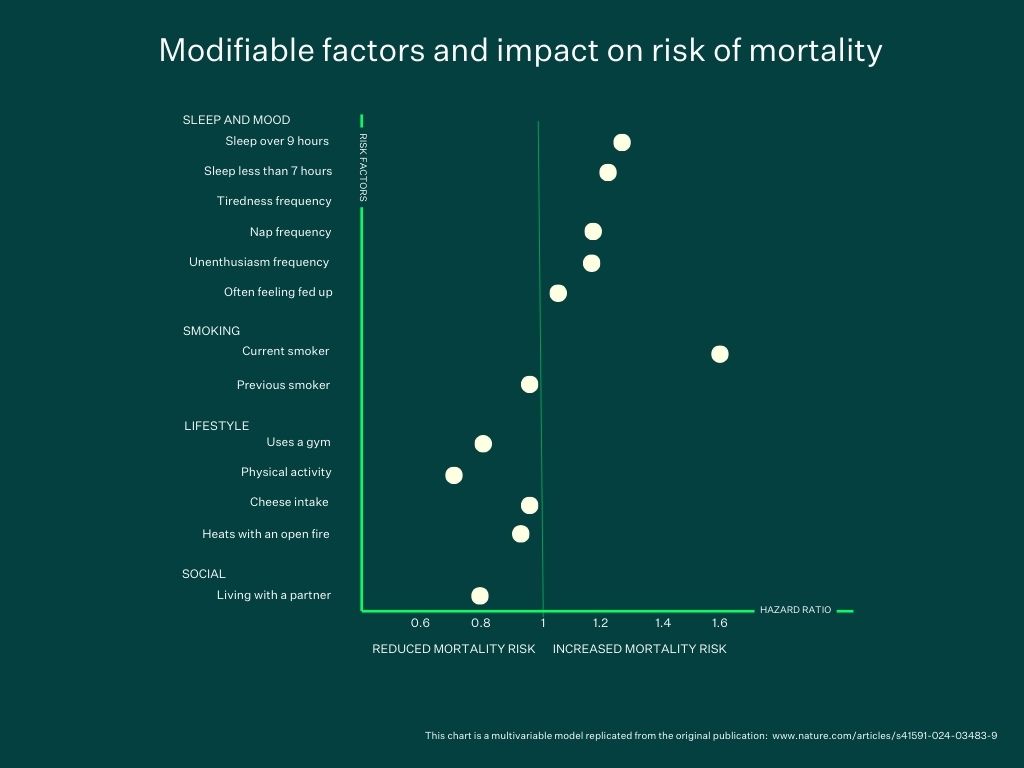We all know physical activity is key to living longer and healthier. Regular physical activity has been credited with reducing risk of premature mortality by around 25%. Now, a comprehensive study reinforces the value of exercise, while shining a light on the importance of social connection when it comes to improving wellbeing and warding off early death.

The findings come after researchers explored how a wide variety of environmental and genetic factors influence the aging process, disease risk and mortality. Pulling extensive data from a biomedical database of over half a million people, the scientists found:
- Environmental factors such as the amount of social connection, physical activity and stress levels have a significant impact on mortality risk.
- Lifestyle factors such as physical activity, going to the gym and living with a partner also have a significant impact on reducing mortality risk.
- Environmental factors can mitigate disease risk to varying degrees. For example, things like liver disease, lung disease and diabetes are strongly tied to environmental or lifestyle factors, (whereas other diseases like breast cancer and Parkinson’s are more significantly impacted by genetics).
Those who have a gym membership are 14 times more active than those who don't.
Bryce Hastings, Les Mills Head of Research, says this is great insight for helping you shape a lifestyle that keeps you in good health for longer. “It highlights the holistic benefits associated with training in a gym setting.” Most notably, a far greater propensity to exercise – those who have a gym membership are 14 times more active than those who don't. “When you exercise alongside others, it really is a triple defence against disease,” says Hastings. “You get all the physiological benefits of exercise, the social connection, and mental health and wellbeing enhancements … All key factors that contribute to a longer, healthier life.”

The fascinating link between social connection and physical health
When people are socially isolated, they tend to have greater levels of cellular inflammation and poorer immune responses. This could be why loneliness is a known risk factor for early death. An earlier analysis of 148 studies involving 300,000 people found that loneliness is associated with a 50% increase in mortality from any cause. Being lonely is linked to a 29% increase in heart disease risk, a 32% increase in stroke risk, plus a 50% increased risk of dementia in older adults. Lack of social connection may also increase susceptibility to viruses and respiratory illness. Basically, whatever ailment an individual may be suffering, loneliness can make the suffering worse and recovery harder.

The loneliness epidemic: Is it really a thing?
Despite technology making connections easier than ever, loneliness and isolation represent profound threats to our health and wellbeing. We’re currently seeing unprecedented levels of isolation and loneliness, with younger generations spending 70% less time with friends than we did a decade ago.
Experts have expressed alarm about the devastating impact, calling loneliness out as being just as deadly as smoking and potentially more dangerous than Covid, cancer and heart disease. In a 2023 report, United States Surgeon General Dr. Vivek Murthy said the impact of loneliness is similar to that of smoking up to 15 cigarettes a day.
A year earlier, researchers asked people how close they felt to others emotionally. Just 39% of adults in the United States said they felt very connected to others; in France the number was 34%; in Brazil the number plummeted to a shocking 23%. Research shows approximately half of US adults are experiencing loneliness, and some of the highest loneliness rates are among young adults. One study shows loneliness rates among young people escalated every year between 1976 and 2019. Young adults are now almost twice as likely to report feeling lonely than those aged over 65. Almost two-thirds of college students report feeling lonely, a striking statistic considering these young people spend time in vibrant campus environments and often live in dorms with others.
What can be done?
The fitness industry is in a powerful position to drive change. There is plenty of evidence that working out with others is a powerful way to create social connections and effectively reduce social isolation and loneliness.
We also know that training in a group works wonders for motivation and those who train alongside others are highly likely to stick with your habits. What’s more, research shows those who do group workouts score significantly higher in terms of stress-reduction and physical, mental, and emotional quality of life.

“Recent trends suggest that a main objective of working out is stress relief and feeling better mentally,” says Hastings. “Combining the mental wellness benefits we get from exercise with social connection greatly enhances this effect.”
It seems the more people who discover the life-changing benefits of group training, the greater potential we have to live longer, healthier and happier lives.
Find out more about how working out together works wonders.









